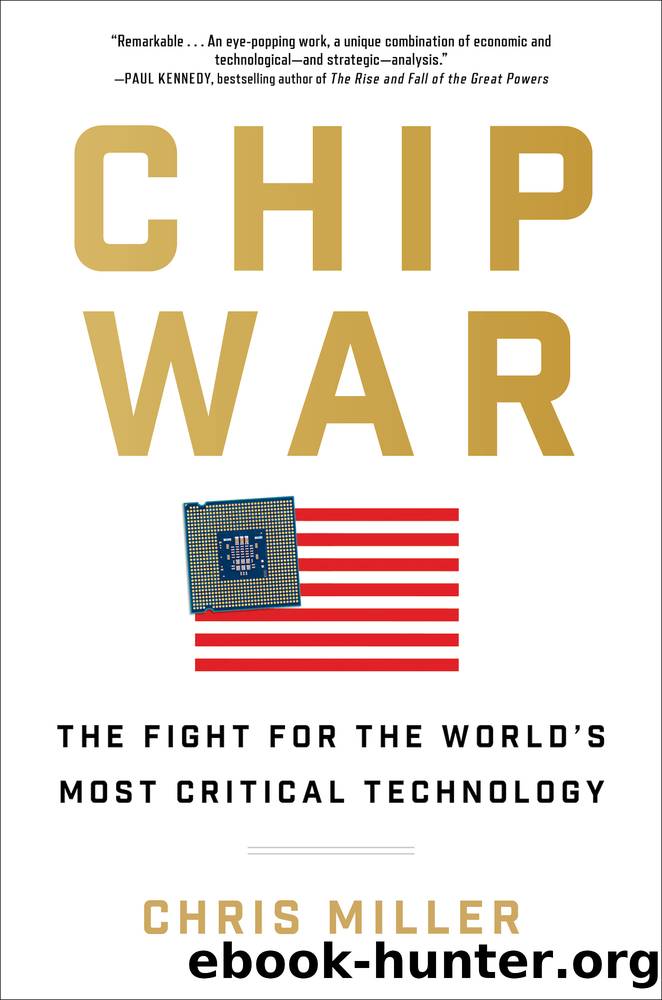Chip War : The Fight for the World's Most Critical Technology (9781982172022) by Miller Chris

Author:Miller, Chris
Language: eng
Format: epub
Publisher: Simon & Schuster
Published: 2022-10-04T00:00:00+00:00
CHAPTER 41 How Intel Forgot Innovation
At least the United States could count on Intel. The company had an unparalleled position in the semiconductor industry. The old leadership was long goneâAndy Grove died in 2016, while Gordon Moore, now in his nineties, retired to Hawaiiâbut the reputation of having commercialized the DRAM and invented the microprocessor remained. No company had a better track record combining innovative chip design with manufacturing prowess. Intelâs x86 architecture remained the industry standard for PCs and data centers. The PC market was stagnant, because it seemed nearly everyone already had a PC, but it remained remarkably profitable for Intel, providing billions of dollars a year that could be reinvested into R&D. The company spent over $10 billion a year on R&D throughout the 2010s, four times as much as TSMC and three times more than the entire budget of DARPA. Only a couple of companies in the world spent more.
As the chip industry entered the EUV era, Intel looked poised to dominate. The company had been crucial to EUVâs emergence, thanks to Andy Groveâs initial $200 million bet on the technology in the early 1990s. Now, after billions of dollars of investmentâa substantial portion of which had come from IntelâASML had finally made the technology a reality. Yet rather than capitalizing on this new era of shrinking transistors, Intel squandered its lead, missing major shifts in semiconductor architecture needed for artificial intelligence, then bungling its manufacturing processes and failing to keep up with Mooreâs Law.
Intel remains enormously profitable today. Itâs still Americaâs biggest and most advanced chipmaker. However, its future is more in doubt than at any point since Groveâs decision in the 1980s to abandon memory and bet everything on microprocessors. It still has a shot at regaining its leadership position over the next half decade, but it could just as easily end up defunct. Whatâs at stake isnât simply one company, but the future of Americaâs chip fabrication industry. Without Intel, there wonât be a single U.S. companyâor a single facility outside of Taiwan or South Koreaâcapable of manufacturing cutting-edge processors.
Intel entered the 2010s as an outlier in Silicon Valley. Most of Americaâs biggest firms in the market for logic chips, including Intelâs archrival AMD, had sold their fabs and focused only on design. Intel stuck stubbornly to its integrated modelâcombining semiconductor design and manufacturing in one companyâwhich executives there thought was still the best way to churn out chips. The companyâs design and manufacturing processes were optimized for each other, Intelâs leaders argued. TSMC, by contrast, had no choice but to adopt generic manufacturing processes that could work just as well for a Qualcomm smartphone processor as an AMD server chip.
Intel was right to perceive some benefits of an integrated model, but there were substantial downsides. Because TSMC manufactures chips for many different companies, it now fabricates nearly three times as many silicon wafers per year as Intel, so it has more chance to hone its process. Moreover, where Intel saw chip design startups as a threat, TSMC saw potential customers for manufacturing services.
Download
This site does not store any files on its server. We only index and link to content provided by other sites. Please contact the content providers to delete copyright contents if any and email us, we'll remove relevant links or contents immediately.
| ASVAB | GED |
| GRE | NCLEX |
| PRAXIS | SAT |
| See more | Flash Cards |
| Study Guides | Study Skills |
| Workbooks |
Talking to Strangers by Malcolm Gladwell(13225)
The Compound Effect by Darren Hardy(8812)
Tools of Titans by Timothy Ferriss(8219)
Wonder by R. J. Palacio(8011)
The Lover by Duras Marguerite(7831)
A Court of Wings and Ruin by Sarah J. Maas(7653)
The Circle by Dave Eggers(7038)
Deep Work by Cal Newport(6881)
Kaplan MCAT General Chemistry Review by Kaplan(6867)
To All the Boys I've Loved Before by Jenny Han(5776)
Wiseguy by Nicholas Pileggi(5672)
The Body: A Guide for Occupants by Bill Bryson(4975)
1,001 ASVAB Practice Questions For Dummies by Powers Rod(4453)
Eat That Frog! by Brian Tracy(4436)
Cracking the GRE Premium Edition with 6 Practice Tests, 2015 (Graduate School Test Preparation) by Princeton Review(4227)
Pre-Suasion: A Revolutionary Way to Influence and Persuade by Robert Cialdini(4151)
Barron's AP Biology by Goldberg M.S. Deborah T(4100)
ACT Math For Dummies by Zegarelli Mark(3996)
Alive: The Story of the Andes Survivors by Piers Paul Read(3970)
